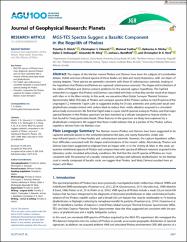MGS-TES Spectra Suggest a Basaltic Component in the Regolith of Phobos

Göster/
Erişim
info:eu-repo/semantics/openAccessTarih
2018Yazar
Glotch, Timothy D.Edwards, Christopher S.
Yeşiltaş, Mehmet
Shirley, Katherine A.
McDougall, Dylan S.
Kling, Alexander M.
Herd, Christopher D. K.
Üst veri
Tüm öğe kaydını gösterÖzet
Plain Language Summary The origins of the Martian moons Phobos and Deimos have been the subjects of considerable debate. Visible and near-infrared spectra of these bodies are dark and nearly featureless, with red slopes of varying degrees. These spectra are generally consistent with those of carbonaceous asteroids, leading to the hypothesis that Phobos and Deimos are captured carbonaceous asteroids. The shapes and inclinations of the orbits of Phobos and Deimos present problems for the asteroid capture hypothesis. This had led researchers to suggest that Phobos and Deimos coaccreted with Mars or that they are the result of an impact with Mars or in the Mars vicinity. In this work, we reexamine Mars Global Surveyor Thermal Emission Spectrometer (MGS-TES) data of Phobos and compare spectra of the Phobos surface to mid-IR spectra of the ungrouped C2 meteorite Tagish Lake (a suggested analog for D-class asteroids) and particulate basalt and phyllosilicate samples (mixed with carbon black to reduce their visible albedos) acquired in a simulated airless body environment. We find that Tagish Lake is a poor mid-IR spectral analog to Phobos and that major spectral features in the Phobos spectrum are best matched by a silicate transparency feature similar to that found for finely particulate basalt. Other features in the spectrum are likely best explained by a phyllosilicate component. We suggest that these results indicate that at a portion of the Phobos surface regolith is derived from the Martian crust. The Martian moons Phobos and Deimos have been suggested to be captured asteroids based on the similarities between the dark, red, nearly featureless visible and near-infrared spectra of these bodies and carbonaceous asteroids. However, the capture hypothesis suffers from difficulties associated with the shapes and inclinations of the moons' orbits. Alternatively, Phobos and Deimos have been suggested to originate from an impact with, or in the vicinity of, Mars. In this work, we examine midinfrared spectra of Phobos and compare them with spectra of different materials acquired in the laboratory under simulated airless body conditions. We find that the mid-IR spectra of Phobos are most consistent with the presence of a basaltic component, perhaps with admixed phyllosilicates. As the Martian crust is mostly composed of basaltic rocks, we suggest that Phobos (and likely Deimos) resulted from an impact with Mars.


















